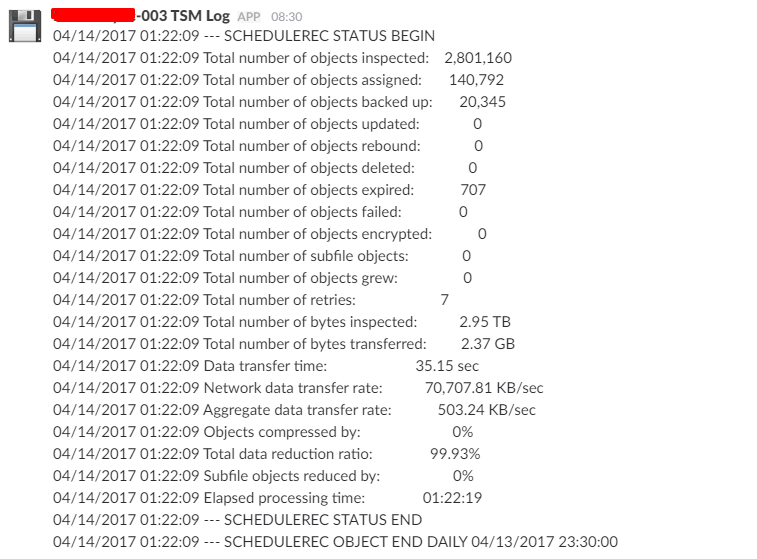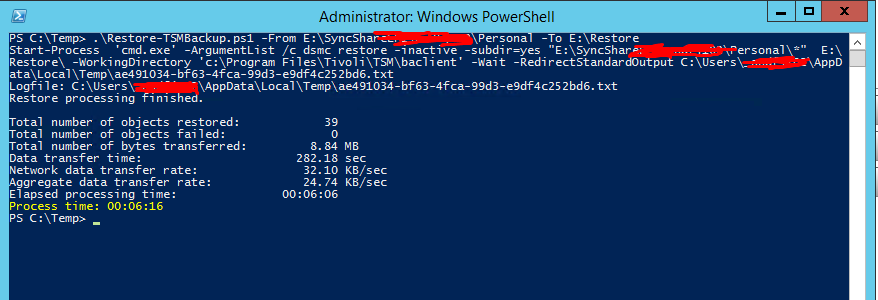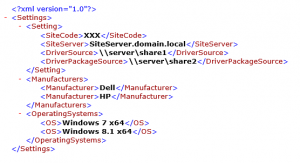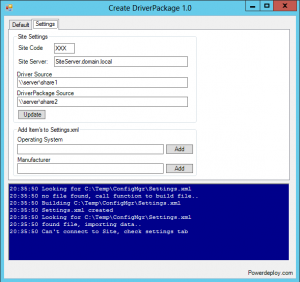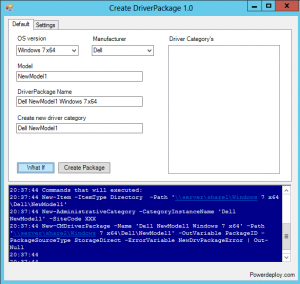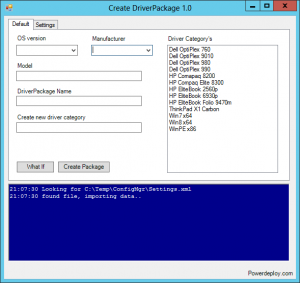# Import ConfigMgr Module
Import-Module ($env:SMS_ADMIN_UI_PATH.Substring(0,$env:SMS_ADMIN_UI_PATH.Length – 5) + 'ConfigurationManager.psd1')
# - - - Settings - - -
$SiteCode = '007:'
# Number of days in report
$DaysToShow = '-7'
# Mail settings
$smtpserver = "your.smtp.server"
$MailSubject = "ConfigMgr Week Report"
$MailRecipients = "CMAdministrator@domain.com","CMPoweUser@domain.com"
$FromAddress = "cmreports@domain.com"
# Tempfile to store data
$msgfile = 'c:tempmailmessage.txt'
# - - - End Settings - - -
# Create file
New-Item $msgfile -ItemType file -Verbose -Force
Set-Location $SiteCode
$StartTime = (Get-Date)
# Get data from ConfigMgr
$NewApplications = Get-CMApplication | ? DateCreated -gt (get-date).AddDays($DaysToShow) | Select LocalizedDisplayName,LastModifiedBy, DateCreated | Sort-Object DateCreated
$ModifiedApplications = Get-CMApplication | ? DateLastModified -gt (get-date).AddDays($DaysToShow) | Select LocalizedDisplayName,LastModifiedBy, DateLastModified | Sort-Object DateLastModified
$NewCI = Get-CMConfigurationItem | ? DateCreated -gt (get-date).AddDays($DaysToShow) | Select LocalizedDisplayName,LastModifiedBy, DateCreated | Sort-Object DateCreated
$ModifiedCI = Get-CMConfigurationItem | ? DateLastModified -gt (get-date).AddDays($DaysToShow) | Select LocalizedDisplayName,LastModifiedBy, DateLastModified | Sort-Object DateLastModified
$NewBaselines = Get-CMBaseline | ? DateCreated -gt (get-date).AddDays($DaysToShow) | Select LocalizedDisplayName,LastModifiedBy, DateCreated | Sort-Object DateCreated
$ModifiedBaselines = Get-CMBaseline | ? DateLastModified -gt (get-date).AddDays($DaysToShow) | Select LocalizedDisplayName,LastModifiedBy, DateLastModified | Sort-Object DateLastModified
$DriverPackages = Get-CMDriverPackage | ? SourceDate -gt (get-date).AddDays($DaysToShow) | Select Name,SourceDate | Sort-Object SourceDate
$NewBoundarys = Get-CMBoundary | ? CreatedOn -gt (Get-Date).AddDays($DaysToShow) | Select DisplayName, ModifiedBy ,CreatedOn | Sort-Object CreatedOn
$ModifiedBoundarys = Get-CMBoundary | ? ModifiedOn -gt (Get-Date).AddDays($DaysToShow) | Select DisplayName, ModifiedBy, ModifiedOn | Sort-Object ModifiedOn
$NewDeployments = Get-CMDeployment | ? CreationTime -gt (Get-Date).AddDays($DaysToShow) | Select CollectionName,CreationTime,SoftwareName | Sort-Object CreationTime
$Bootimages = Get-CMBootImage | ? SourceDate -gt (Get-Date).AddDays($DaysToShow) | Select Name,Description,SourceDate | Sort-Object SourceDate
$Packages = Get-CMPackage | ? SourceDate -gt (get-date).AddDays($DaysToShow) | Select Name,SourceDate | Sort-Object SourceDate
$EndTime = (Get-Date)
function New-Table (
$Title,
$Topic1,
$Topic2,
$Topic3
)
{
Add-Content $msgfile "<h3>$Title</h3>"
Add-Content $msgfile "<p><table cellspacing=""15"">"
Add-Content $msgfile "<tr><th>$Topic1</th><th>$Topic2</th><th>$Topic3</th></tr>"
}
function New-TableRow (
$col1,
$col2,
$col3
)
{
Add-Content $msgfile "<tr><td>$col1</td><td>$col2</td><td>$col3</td></tr>"
}
function New-TableEnd {
Add-Content $msgfile "</table></p>"}
if ($NewDeployments -ne $null ) {
New-Table -Title "New Deployments" -Topic1 "SoftwareName" -Topic2 "Deployed to" -Topic3 "CreationTime"
foreach ($app in $NewDeployments ) {New-TableRow -col1 $app.SoftwareName -col2 $app.CollectionName -col3 $app.CreationTime}
New-TableEnd
}
if ($NewApplications -ne $null ) {
New-Table -Title "New Applications" -Topic1 "LocalizedDisplayName" -Topic2 "LastModifiedBy" -Topic3 "DateCreated"
foreach ($app in $NewApplications ) {New-TableRow -col1 $app.LocalizedDisplayName -col2 $app.LastModifiedBy -col3 $app.DateCreated}
New-TableEnd
}
if ($ModifiedApplications -ne $null ) {
New-Table -Title "Modified Applications" -Topic1 "LocalizedDisplayName" -Topic2 "LastModifiedBy" -Topic3 "DateLastModified"
foreach ($app in $ModifiedApplications ) {New-TableRow -col1 $app.LocalizedDisplayName -col2 $app.LastModifiedBy -col3 $app.DateLastModified}
New-TableEnd
}
if ($Packages -ne $null ) {
New-Table -Title "New/Modified Packages" -Topic1 "Name" -Topic2 "SourceDate"
foreach ($app in $Packages ) {New-TableRow -col1 $app.Name -col2 $app.SourceDate}
New-TableEnd
}
if ($DriverPackages -ne $null ) {
New-Table -Title "New/Modified Driver Packages" -Topic1 "Name" -Topic2 "SourceDate"
foreach ($app in $DriverPackages ) {New-TableRow -col1 $app.Name -col2 $app.SourceDate}
New-TableEnd
}
if ($NewCI -ne $null ) {
New-Table -Title "New CI's" -Topic1 "LocalizedDisplayName" -Topic2 "LastModifiedBy" -Topic3 "DateCreated"
foreach ($app in $NewCI ) {New-TableRow -col1 $app.LocalizedDisplayName -col2 $app.LastModifiedBy -col3 $app.DateCreated}
New-TableEnd
}
if ($ModifiedCI -ne $null ) {
New-Table -Title "Modified CI's" -Topic1 "LocalizedDisplayName" -Topic2 "LastModifiedBy" -Topic3 "DateLastModified"
foreach ($app in $ModifiedCI ) {New-TableRow -col1 $app.LocalizedDisplayName -col2 $app.LastModifiedBy -col3 $app.DateLastModified}
New-TableEnd
}
if ($NewBaselines -ne $null ) {
New-Table -Title "New Baselines's" -Topic1 "LocalizedDisplayName" -Topic2 "LastModifiedBy" -Topic3 "DateCreated"
foreach ($app in $NewBaselines ) {New-TableRow -col1 $app.LocalizedDisplayName -col2 $app.LastModifiedBy -col3 $app.DateCreated}
New-TableEnd
}
if ($ModifiedBaselines -ne $null ) {
New-Table -Title "Modified Baselines" -Topic1 "LocalizedDisplayName" -Topic2 "LastModifiedBy" -Topic3 "DateLastModified"
foreach ($app in $ModifiedBaselines ) {New-TableRow -col1 $app.LocalizedDisplayName -col2 $app.LastModifiedBy -col3 $app.DateLastModified}
New-TableEnd
}
if ($NewBoundarys -ne $null ) {
New-Table -Title "New Boundarys" -Topic1 "DisplayName" -Topic2 "ModifiedBy" -Topic3 "CreatedOn"
foreach ($app in $NewBoundarys ) {New-TableRow -col1 $app.DisplayName -col2 $app.ModifiedBy -col3 $app.CreatedOn}
New-TableEnd
}
if ($ModifiedBoundarys -ne $null ) {
New-Table -Title "Modified Boundarys" -Topic1 "DisplayName" -Topic2 "ModifiedBy" -Topic3 "ModifiedOn"
foreach ($app in $ModifiedBoundarys ) {New-TableRow -col1 $app.DisplayName -col2 $app.ModifiedBy -col3 $app.ModifiedOn}
New-TableEnd
}
if ($Bootimages -ne $null ) {
New-Table -Title "New/Modified Boot Images" -Topic1 "Name" -Topic2 "Description" -Topic3 "SourceDate"
foreach ($app in $Bootimages ) {New-TableRow -col1 $app.Name -col2 $app.Description -col3 $app.SourceDate}
New-TableEnd
}
Add-Content $msgfile "<p>Data collected in $(($EndTime-$StartTime).totalseconds) seconds</p>"
$mailbody = Get-Content $msgfile
Send-MailMessage -Body "$mailbody" -From $FromAddress -to $MailRecipients -SmtpServer $smtpserver -Subject $MailSubject -BodyAsHtml
# Delete tempfile
Remove-Item $msgfile
